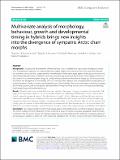Multivariate analysis of morphology, behaviour, growth and developmental timing in hybrids brings new insights into the divergence of sympatric Arctic charr morphs
Abstract
Background: Studying the development of fitness related traits in hybrids from populations diverging in sympatry is a fundamental approach to understand the processes of speciation. However, such traits are often affected by covariance structures that complicate the comprehension of these processes, especially because the interactive relationships between traits of different nature (e.g. morphology, behaviour, life-history) remain largely unknown in this context. In a common garden setup, we conducted an extensive examination of a large suit of traits putatively involved in the divergence of two morphs of Arctic charr (Salvelinus alpinus), and investigated the consequences of potential patterns of trait covariance on the phenotype of their hybrids. These traits were measured along ontogeny and involved growth, yolk sac resorption, developmental timing (hatching and the onset of exogeneous feeding), head morphology and feeding behaviour. Results: Growth trajectories provided the strongest signal of phenotypic divergence between the two charr. Strikingly, the first-generation hybrids did not show intermediate nor delayed growth but were similar to the smallest morph, suggesting parental biases in the inheritance of growth patterns. However, we did not observe extensive multivariate trait differences between the two morphs and their hybrids. Growth was linked to head morphology (suggesting that morphological variations in early juveniles relate to simple allometric effects) but this was the only strong signal of covariance observed between all the measured traits. Furthermore, we did not report evidence for differences in overall phenotypic variance between morphs, nor for enhanced phenotypic variability in their hybrids. Conclusion: Our study shed light on the multivariate aspect of development in a context of adaptive divergence. The lack of evidence for the integration of most traits into a single covariance structure suggested that phenotypic constraints may not always favour nor impede divergence toward ecological niches differing in numerous physical and ecological variables, as observed in the respective habitats of the two charr. Likewise, the role of hybridization as a disruptive agent of trait covariance may not necessarily be significant in the evolution of populations undergoing resource polymorphism.
Citation
Horta-Lacueva , Q J-B , Snorrason , S S , Morrissey , M B , Leblanc , C A-L & Kapralova , K H 2021 , ' Multivariate analysis of morphology, behaviour, growth and developmental timing in hybrids brings new insights into the divergence of sympatric Arctic charr morphs ' , BMC Ecology and Evolution , vol. 21 , 170 . https://doi.org/10.1186/s12862-021-01904-8
Publication
BMC Ecology and Evolution
Status
Peer reviewed
ISSN
2730-7182Type
Journal article
Description
This work was fully funded by the Icelandic Centre of Research, RANNÍS (Icelandic Research Fund grant no.173802-051).Collections
Items in the St Andrews Research Repository are protected by copyright, with all rights reserved, unless otherwise indicated.

